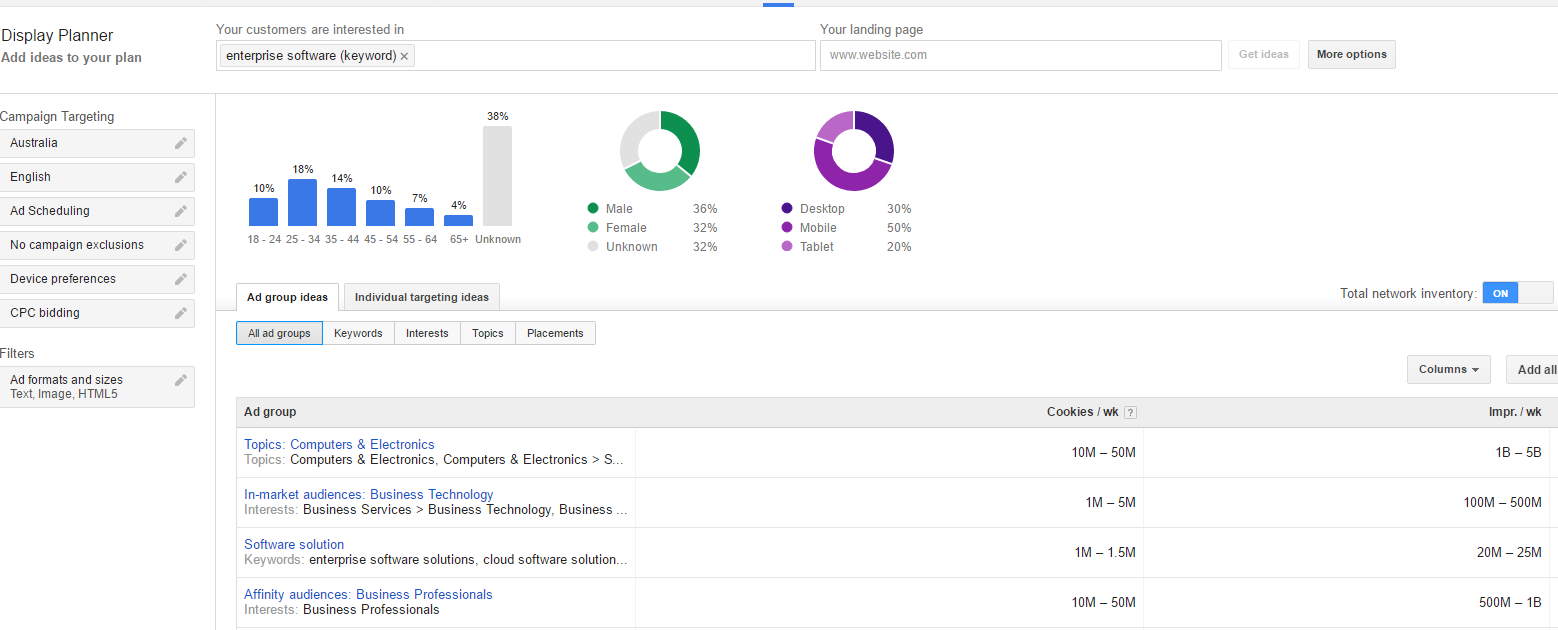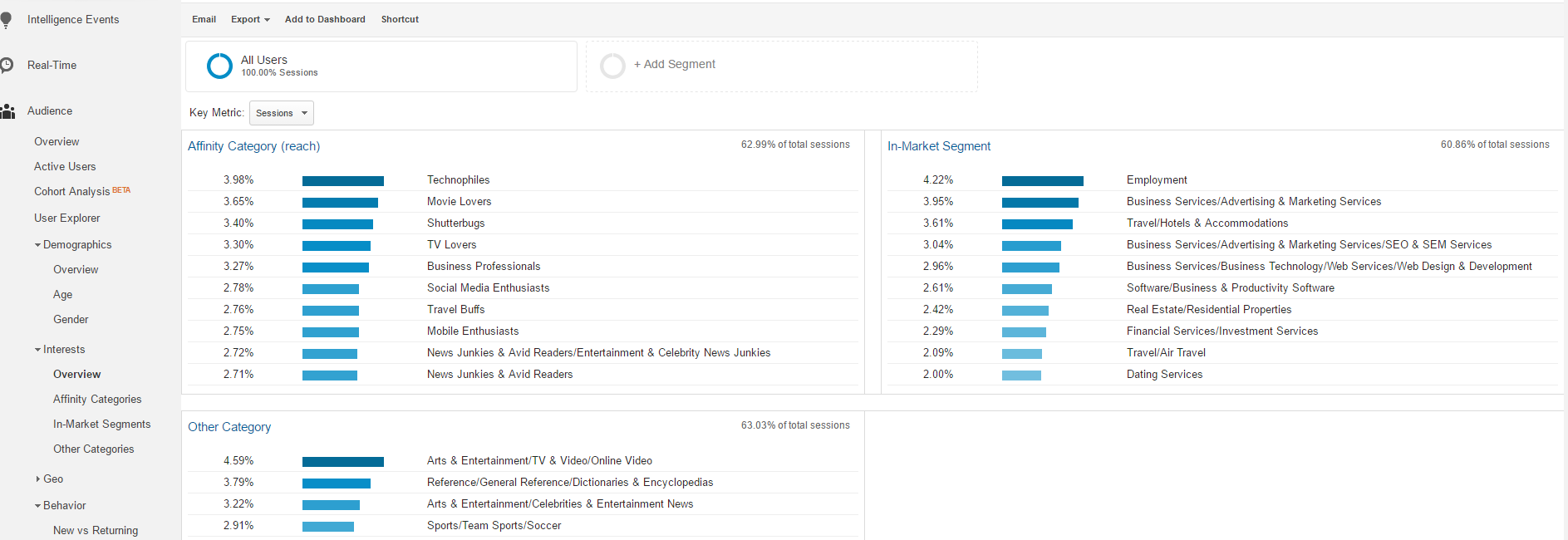It’s a huge surprise to me that Display campaigns are still a set-and-forget thing for many businesses. As it lies buried in some AdWords accounts, the potential business opportunities also lie dormant. While it’s true that you get cheap clicks more easily on Display Networks, it’s not the best way to use it in your marketing mix. Once you’ve been exposed to the multiple targeting methods on Display Networks, you will start to realise how powerful Display campaigns can be to reach your dream audiences, and ultimately, achieve your business goals faster.
The Basic Targeting Methods
Contextual Targeting (Keywords)
Contextual targeting method shows your banner ads on themed web pages based on your keywords. Build an ad group with 5 to 10 closely related keywords and Google’s algorithm will find pages that either contain or are related to these keywords. It’s the “random person in the right context” kind of targeting but remember, your ads can also be shown on pages where the users have recently visited keyword-related pages, even though the pages your ads are shown on have nothing to do with your keywords.
Interest Categories
Different from contextual targeting, interest-based targeting is the “right person in a random context”, targeting people who have particular interests (Affinity Audiences), or people who are actively researching and comparing products or services similar to yours (In-Market Audiences).
Topic targeting
Topic targeting is like the modern equivalent of traditional media buying where advertisers spent money buying ad spaces on newspapers in different topic sections like finance, beauty, and automotive. The difference with Google Display is that you’ve got even more topics to choose from, and these topics can be very granular (e.g., Computer & Electronics > Software > Business & productivity Software > Project Management Software). Instead of paying tonnes of money on viewership without knowing the results (like magazines or newspapers), you only pay when people click on your ads (same with Search), which is far more measurable and definitely more cost-effective.
Remarketing
Showing your ads to people who have visited your site (Remarking) has become increasingly valuable as more marketers realise the importance of mapping customer journeys and multiple touch points. In remarketing, as these are people that have been on your site before, try getting more personal in your message to add value to each interaction with these potential customers.
Managed Placement
You’ll have more control in managed placement, where you nominate the pages that will show your ads. You can either research the most suitable sites based on your own insights, or by using Display Planner to scout for them. Once your campaigns are gaining traffic, you can also analyse the automatic placements under other targeting methods, and include those high performing ones into your managed placement.
Demographic Targeting
This targeting method is a marketers favourite as it defines audiences very clearly by demographic metrics like gender, age, and parental status. This would be extremely useful if you have a product or service that is specifically tailored to a certain group. For example, if you were selling babysitting services then you’d want to only target parents with small children.
Advanced Targeting
This is where targeting gets more complicated and also more powerful. If your goal is to increase brand awareness, you may want to start out by testing each targeting method separately to find the most effective ones. If you want to generate more qualified leads and consequently sales, then you need to use advanced targeting to mix different targeting methods. In this way, you are targeting more specific customers who are more likely to take the desired action on your site. However, always check if there are enough impressions for meaningful targeting by checking the estimated impression volume.
Keywords + Interest
Remember we mentioned above that keywords targeting is “the random person in the right context” and the interest targeting is “the right person in the random context”? Combining these two is the perfect mix; “the right person in the right context”. This is your most desirable segment of your target market.
Placement + Topics
Say you’re selling enterprise software and you have certain placements in mind, like Forbes and The Australian, as these are sites that resonate well with your brand image. However, you don’t want to show your ads on web pages that talk about fashion and beauty. How do you do that? This can be done by either excluding unwanted topics, or only including topics that are most relevant to your business.
In-Market + Remarketing
This is a highly sales-oriented mix targeting people who have both visited your site and are actively searching for similar products. Audiences within this group are situated towards the bottom of the purchase funnel and are therefore more likely to convert into a sale, so ensure your messaging as the impact to pull them over the line.
Get The Insight
Display Planner

Like the Keyword Planner, the Display Planner gives you the overview of targeting estimates based on your keywords. It generates targeting ideas based on keywords, interests, topics, demographics and placements, making it a great way to plan out your display targeting.
Google Analytics

Google Analytics is a gold mine of customer insights. By going into the Demographics, Interests, or Behaviour audience segmentations, you can uncover the very details of your customers and create new targeting mixes based on those insights. Check out this article in PPChero that teaches you how.
Best Practices
Relevant and Compelling Creatives
All targeting techniques put aside, it is eventually the communication between you and your potential customers. The visuals need to be compelling and messages adding values to them. This could be your first ever interaction with your customer, or the last one before or without a transaction. Remember, only highly relevant creatives can achieve the goal you want.
The above targeting options help you find the right customers, but relevant creative (your images and copy) is what will attract their attention, and get them to interact. An effective display ad should increase value to the user journey and build a positive brand image for your business. Displaying irrelevant ads or promoting products people already bought will probably annoy them. So in short, it’s the right targeting and creatives working in conjunction with each other that will get you the results you want.
Landing Page Relevancy
If you have a high bounce rate for display ads, it’s time to reflect on your landing page experience;
- Does it convey a coherent message with your ads?
- Does it have a proper Call-To-Action?
- Is the loading speed fast?
- Is the design appealing and easy to navigate?
The Landing page experience not only determines your goal completion, it also plays an important part in improving your ad quality score which determines whether your ads are shown or not.
Frequency Control
Recurring ads can become cumbersome to the user, so we use frequency capping to solve this. Frequency capping allows you to set the number of times an individual user will be shown your ad. This helps you combat ad fatigue and maintain a positive brand image. After all, if it’s shown numerous times without action you can assume that the person will not interact with it, so it’s better to stop presenting the ad to this person and instead try somebody else.
Constantly Test and Optimise
As with any kind of marketing, display targeting is all about constant testing and optimisation. It’s always good to start out by testing several targeting mixes, then dig into data and see what’s working and what’s not until you find the best mixes for your needs.
Experiment & optimise
While it may seem daunting at first to see so many targeting options and wonder which ones will be the most effective, this article hopefully clarifies some basic methods so you can build up your confidence and try out some new targeting mixes.
Have you recently started your display targeting ads? What did you have the most success with? Let us know in the comments!
